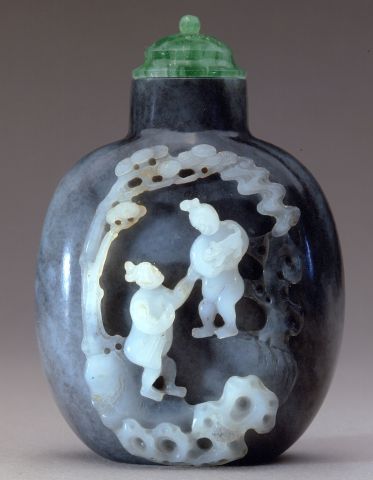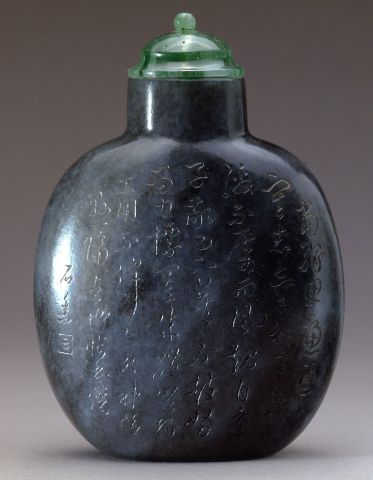

Bottle ID: 381
BLACK AND WHITE, TWO BOYS
Date: 1800-1900
Height: 74 mm
Nephrite, of light and dark gray tones, well hollowed, of ovoid form with a concave oval foot; carved using the paler color as a cameo on one side with two naked boys, one holding a mythical beast, the other a leaf-shaped fan, standing beneath a pine and beside an ornate convoluted rock, on a rocky ground with another elaborate convoluted rock in the foreground on which a bird is perched, a wisp of formalized clouds joining the upper rock with the pine tree to create an integral oval frame for the picture; the other side with a long inscription in draft script, followed by 'Compiler Li' and the signature 'Shixiang' (‘stone fragrance’) with one seal of the artist Yun (‘Cloud’). The inscription translates as follows:
'When we engage in a thoroughgoing examination of the way he then thought, we discover that his mind in all its strength had become utterly tranquil, free from excitement and all severity, so that the style of his calligraphy accordingly became broad and far-reaching. Beginning with Zijing on down, none failed to exert themselves to the utmost to create a style of their own with his as standard. But how could what he accomplished ever be attributed to just his working harder at his craft than others, for it was actually because his personal quality of expression was so far above and beyond theirs!'
Attributed to the Suzhou School.
Similar Examples:
Crane Collection no. 85
Lawrence, Clare. Miniature Masterpieces from the Middle Kingdom - The Monimar Collection of Chinese Snuff Bottles, 1996, pp. 144-145, no. 66.194.
Stevens, Bob C. The Collector's Book of Snuff Bottles, 1976, p. 121, nos. 433 and 434.
Sotheby's, Hong Kong, May 5, 1994, lot 1496.
Sotheby's, New York, September 14, 2010, lot 189, The Joe Grimberg Collection.
Provenance:
Hugh Moss [HK] Ltd.
Published:
JICSBS, Autumn 2007, front cover
The Suzhou School uses color with dramatic effect. There is a small superbly made group of black, grey and white nephrite bottles where the white or pale grey inclusions are carved against the black ground. Often the ground itself is also carved in lower relief or incised to add more detail to the subject. In some cases both sides have been carved pictorially, in other cases the reverse side has been incised with a poetic inscription and is accompanied occasionally by a signature. The 'black and white' bottles are, to many collectors, the zenith of this school combining artistry and technique to a degree that is lacking elsewhere. The Suzhou School is also renowned for its inscriptions appearing in various guises and locations on the bottles. On a number of the black, grey and white nephrite group the inscription is incised on one face of the bottle, usually accepted as the reverse of the piece, although on occasion it is carved into the smooth face of the rockwork or to one side of the scene.
The black and white jade has on its reverse side an inscription from part of the text by the great 7th century calligrapher Sun Guoting (648-703), the Shupu, "The Treatise on Calligraphy". The Shupu was composed around 687 AD and extols the art of earlier calligraphy. The original work has a text containing over 3,500 characters, of which less than 50 are inscribed here. Sun Guoting's personal name was Qianli and this fits with the end of the inscription reading 'Compiler Li' referencing Sun Guoting. This section of the prose relates to Wang Xizhi's calligraphy in his later years and begins in the Shupu as follows: 'The calligraphy of the Right Army Commandant (Wang Xizhi, 303 - 361), of his later years exhibits many marvelous qualities'. The reference to Zijing is to the son of Wang Xizhi, whose name was Wang Xianzhi (344-388), and who was also a great calligrapher.
< Back to full list

 English
English 中文
中文